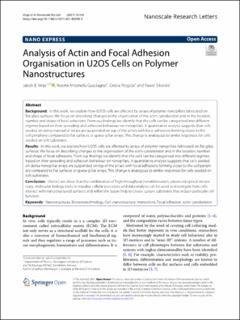| dc.contributor.author | Vinje, Jakob | |
| dc.contributor.author | Guadagno, Noemi Antonella | |
| dc.contributor.author | Progida, Cinzia | |
| dc.contributor.author | Sikorski, Pawel | |
| dc.date.accessioned | 2022-03-10T12:52:40Z | |
| dc.date.available | 2022-03-10T12:52:40Z | |
| dc.date.created | 2021-09-28T11:01:09Z | |
| dc.date.issued | 2021 | |
| dc.identifier.citation | Nanoscale Research Letters. 2021, 16 (1), . | en_US |
| dc.identifier.issn | 1931-7573 | |
| dc.identifier.uri | https://hdl.handle.net/11250/2984286 | |
| dc.description.abstract | Background
In this work, we explore how U2OS cells are affected by arrays of polymer nanopillars fabricated on flat glass surfaces. We focus on describing changes to the organisation of the actin cytoskeleton and in the location, number and shape of focal adhesions. From our findings we identify that the cells can be categorised into different regimes based on their spreading and adhesion behaviour on nanopillars. A quantitative analysis suggests that cells seeded on dense nanopillar arrays are suspended on top of the pillars with focal adhesions forming closer to the cell periphery compared to flat surfaces or sparse pillar arrays. This change is analogous to similar responses for cells seeded on soft substrates.
Results
In this work, we explore how U2OS cells are affected by arrays of polymer nanopillars fabricated on flat glass surfaces. We focus on describing changes to the organisation of the actin cytoskeleton and in the location, number and shape of focal adhesions. From our findings we identify that the cells can be categorised into different regimes based on their spreading and adhesion behaviour on nanopillars. A quantitative analysis suggests that cells seeded on dense nanopillar arrays are suspended on top of the pillars with focal adhesions forming closer to the cell periphery compared to flat surfaces or sparse pillar arrays. This change is analogous to similar responses for cells seeded on soft substrates.
Conclusion
Overall, we show that the combination of high throughput nanofabrication, advanced optical microscopy, molecular biology tools to visualise cellular processes and data analysis can be used to investigate how cells interact with nanostructured surfaces and will in the future help to create culture substrates that induce particular cell function. | en_US |
| dc.language.iso | eng | en_US |
| dc.publisher | Springer | en_US |
| dc.rights | Navngivelse 4.0 Internasjonal | * |
| dc.rights.uri | http://creativecommons.org/licenses/by/4.0/deed.no | * |
| dc.title | Analysis of Actin and Focal Adhesion Organisation in U2OS Cells on Polymer Nanostructures | en_US |
| dc.type | Peer reviewed | en_US |
| dc.type | Journal article | en_US |
| dc.description.version | publishedVersion | en_US |
| dc.source.pagenumber | 14 | en_US |
| dc.source.volume | 16 | en_US |
| dc.source.journal | Nanoscale Research Letters | en_US |
| dc.source.issue | 1 | en_US |
| dc.identifier.doi | 10.1186/s11671-021-03598-9 | |
| dc.identifier.cristin | 1939647 | |
| dc.relation.project | Norges forskningsråd: 295864 | en_US |
| cristin.ispublished | true | |
| cristin.fulltext | original | |
| cristin.fulltext | postprint | |
| cristin.qualitycode | 1 | |

